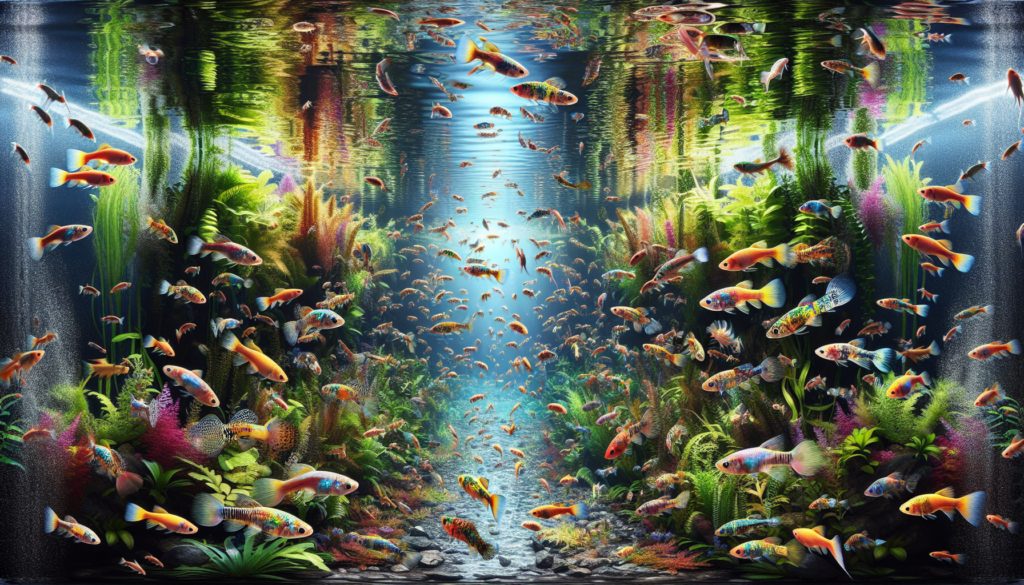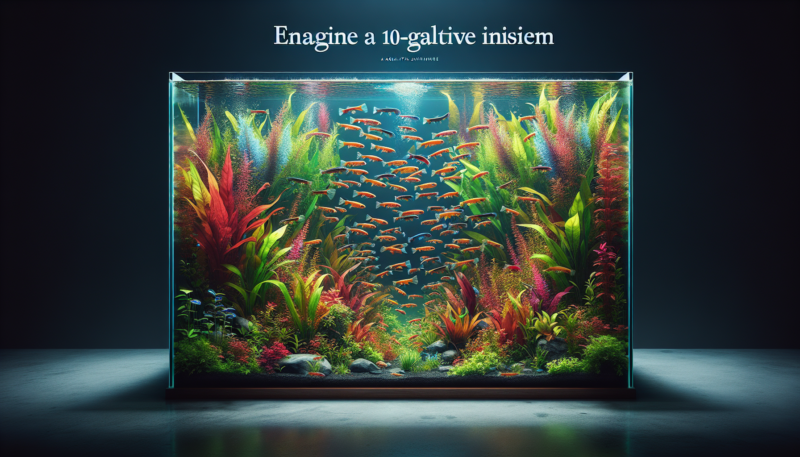Are you a fan of guppies and considering setting up a 10 gallon tank for these beautiful fish? If so, you may be wondering just how many guppies you can comfortably accommodate in this size tank. Well, fret not my friend, because we’ve got all the answers you need! In this article, we’ll explore the ideal number of guppies you can keep in a 10 gallon tank, ensuring a thriving and happy community for your aquatic friends. So, let’s dive in and find out the magic number of guppies for your tank!

Factors to Consider
Guppy Size
When determining how many guppies you can keep in your 10-gallon tank, the size of the guppies is an important factor to consider. Guppies come in various sizes, with males typically being smaller than females. Larger guppies will require more space and can impact the overall number of fish you can safely keep in your tank.
Growth Potential
It’s important to consider the growth potential of your guppies when calculating how many can be housed in your 10-gallon tank. Guppies have the ability to grow quickly, especially if they are provided with optimal water conditions and a well-balanced diet. Failing to account for their growth potential can result in overcrowding and negative impacts on their health and well-being.
Social Behavior
Guppies are known to be social fish and thrive in communities. They display shoaling behavior, which means they prefer to live in groups. When determining the number of guppies for your tank, it’s crucial to consider their social needs. Keeping fewer than the recommended number can lead to stress and loneliness for your guppies.
Aquarium Environment
The overall environment of your aquarium should also be taken into account when deciding how many guppies you can keep in your 10-gallon tank. Factors such as the presence of plants, hiding spots, and suitable water parameters play a role in the well-being of your guppies. Providing a well-equipped and comfortable environment will allow for a greater number of guppies to coexist harmoniously.
General Rule of Thumb
1 Inch of Fish per Gallon
A general rule of thumb often used in the aquarium hobby is to have 1 inch of fish per gallon of tank capacity. While this can provide a basic guideline, it should not be the sole determining factor for stocking your tank. This rule does not take into account the specific needs and requirements of different fish species, including guppies.
Adjusting for Guppy Size
Guppies are relatively small fish, usually reaching a maximum size of around 2 inches. Considering their size and activity levels, you can slightly adjust the general rule of 1 inch of fish per gallon for guppies. A more suitable guideline for guppies could be 1.5 to 2 inches of fish per gallon to ensure they have sufficient space to swim and thrive comfortably.
Overstocking Risks
Overstocking your 10-gallon tank can lead to various issues, including poor water quality, increased stress levels for your fish, and a higher risk of diseases. It’s important to strike a balance between the number of fish you wish to keep and the capacity of your tank. Overstocking can result in an unhealthy and unstable environment, impacting the well-being of your guppies.
Maximum Number of Guppies
Adult Guppies
Considering the factors mentioned above, a 10-gallon tank can comfortably support around 5 to 7 adult guppies. This number allows for proper social interaction, sufficient swimming space, and reduced risks of overcrowding. However, it’s essential to monitor the behavior and well-being of your guppies closely. If you notice signs of stress or aggression, it may be necessary to decrease the number of guppies in your tank.
Fry (Baby Guppies)
Guppies are notorious for their prolific breeding habits, often resulting in a significant number of fry. While the exact number of fry that can be housed depends on various factors, providing adequate space for the growing fry is essential. A separate breeding tank or additional space in your existing tank is recommended to prevent overpopulation and maintain optimal conditions for both adult guppies and their offspring.
Alternative Options
Nano Fish Species
If you are limited by the tank size and prefer to keep a larger number of fish, considering nano fish species is a viable alternative. Nano fish are small in size, typically reaching a maximum of 1 to 2 inches, making them suitable for smaller tanks like a 10-gallon. They offer the opportunity to keep a greater number of fish while still providing ample swimming space and a diverse aquarium community.
Shrimp and Snails
Another alternative to consider is the addition of shrimp and snails to your 10-gallon tank. Shrimp, such as cherry shrimp or amano shrimp, and snails, like nerite snails or mystery snails, can add interest and diversity to your aquarium. These organisms have minimal space requirements and can coexist peacefully with guppies. However, it’s important to ensure compatibility and appropriate water parameters for all inhabitants.
Aquatic Plants
Incorporating live aquatic plants into your 10-gallon tank not only enhances its aesthetic appeal but also provides essential benefits for your guppies. Plants can help maintain water quality by absorbing nitrates, provide hiding spots, and create a more natural environment. Adding plants can increase the overall capacity for fish in your tank while maintaining a healthy and balanced ecosystem.

Tank Size Considerations
Minimum Tank Size for Guppies
While a 10-gallon tank can support a small community of guppies, it is important to note that this represents the minimum tank size for these fish. Larger tanks, such as a 20-gallon or 30-gallon, provide more swimming space, increased stability, and reduced maintenance requirements. If possible, upgrading to a larger tank will allow for a greater number of guppies and promote better overall fish health.
Exceeding the Minimum Tank Size
If you decide to exceed the minimum tank size requirements and upgrade to a larger tank, the number of guppies you can comfortably keep will increase. For example, a 20-gallon tank can support around 10 to 14 adult guppies, while a 30-gallon tank can accommodate even more. Increasing the tank size not only provides more space for your fish but also offers greater flexibility in terms of aquascape design and compatibility with other species.
Setting Up the Tank
Proper Filtration
Maintaining a healthy and clean environment is crucial for the well-being of your guppies. A good filtration system is essential to remove waste, excess nutrients, and maintain proper water parameters. When setting up your 10-gallon tank, opt for a filter that provides adequate mechanical, biological, and chemical filtration. Regular cleaning and maintenance of the filter are necessary to ensure optimal performance.
Heating and Temperature
Guppies are tropical fish and require a stable and appropriate temperature range to thrive. A heater is necessary to maintain the water temperature between 74°F and 82°F (23°C and 28°C). Investing in a reliable heater with an adjustable thermostat will allow you to maintain the ideal temperature for your guppies, promoting their overall health and vitality.
Decor and Substrate
Creating a comfortable and stimulating environment for your guppies is essential. Provide ample hiding spots and areas for exploration by incorporating decorations such as rocks, caves, and driftwood. A sandy or fine-gravel substrate is suitable for guppies, as it mimics their natural habitat and allows for easy foraging. Live or artificial plants can also be added for aesthetic appeal and to provide additional cover for your fish.
Water Quality and Maintenance
Regular monitoring of water quality parameters, such as pH, ammonia, nitrite, and nitrate levels, is vital for the health of your guppies. Aim for a pH range of 7.0 to 8.0 and maintain ammonia and nitrite levels at zero. Frequent water changes, generally around 25% to 50% every two weeks, help maintain water quality and reduce the risk of disease. Ensure that the newly added water is at the appropriate temperature and treated with a suitable water conditioner to remove chlorine and chloramine.
Breeding Guppies
Separate Breeding Tank
Breeding guppies can be an exciting endeavor, but it requires careful planning and consideration. Set up a separate breeding tank to provide a safe and controlled environment for the fry and minimize the risk of them being eaten by adult guppies or other tankmates. A smaller tank, such as a 5-gallon, can be used for breeding purposes and equipped with appropriate filtration and heating.
Space for Fry
If you plan to breed guppies, make sure to allocate sufficient space for the growing fry. As mentioned earlier, a separate tank or partitioned area within your existing tank can be utilized for this purpose. Transfer the fry to the designated space once they are born to protect them from adult guppies and allow them to grow without competition for resources.
Potential Overpopulation
Guppies are known for their ability to breed rapidly, and overpopulation can become an issue if not managed carefully. Monitor the number of fry being produced and assess whether you have the appropriate resources and space to accommodate them. Consider options such as trading or giving away excess fry to fellow hobbyists or local fish stores to prevent overcrowding in your tanks.
Monitoring and Adaptation
Fish Behavior and Stress
Regular observation of your guppies’ behavior is important to ensure their well-being. Look out for signs of stress, such as decreased appetite, lethargy, or aggressive behavior. Any unusual behavior should be addressed promptly to maintain the health and happiness of your fish. Taking note of their interactions and making adjustments accordingly can help create a harmonious aquarium community.
Water Quality Testing
Consistently monitoring the water quality parameters is crucial for the long-term health of your guppies. Test the water regularly using appropriate test kits to assess the levels of ammonia, nitrite, nitrate, and pH. Maintaining stable and suitable water conditions will help prevent diseases and promote the overall well-being of your fish.
Adapting to Changes
Fishkeeping is a dynamic hobby, and changes in your tank may be necessary from time to time. Whether it’s introducing new tankmates, upgrading to a larger tank, or adjusting the overall setup, it’s important to be adaptable and willing to make changes for the benefit of your guppies. Keeping an open mind and staying informed about best practices will ensure a positive experience for both you and your fish.
Conclusion
When determining how many guppies you can keep in a 10-gallon tank, it’s crucial to consider factors such as guppy size, growth potential, social behavior, and the overall aquarium environment. While a general rule of 1 inch of fish per gallon can provide a basic guideline, it’s important to adjust for guppy size and avoid overstocking. A 10-gallon tank can comfortably house around 5 to 7 adult guppies, with additional considerations for fry. Exploring alternative options like nano fish species, shrimp and snails, and aquatic plants can provide diversity and increase stocking options. Setting up the tank with proper filtration, heating, appropriate decor, and regular water quality maintenance is essential for the well-being of your guppies. Breeding guppies requires a separate breeding tank and thoughtful management of fry population. Monitoring fish behavior, water quality, and being adaptable to changes will ensure a successful and enjoyable experience as a guppy owner.
